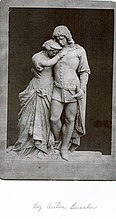Franz Anton Buscher
Franz Anton Anthony Buscher (born November 30, 1825 in Gamburg , † March 2, 1879 in Chicago ) was an American sculptor and wood carver of German origin.
Life
Franz Anton Buscher was the youngest son of the married couple Mathes Buscher (1785–1844) and Anna Maria, geb. Misselbeck (1781-1847). He learned the stonemason trade from his father and at the age of 13 he created a wayside shrine with a Pietà for his home town of Gamburg , which is still preserved. Years of traveling took him to Switzerland and Italy.
After briefly returning to his parents' company, he emigrated to America in 1844. In New York he first worked as an ornament carver . He later bought a farm, which he soon gave up. He then settled in Chicago at 1123 S. May Street and opened a wood-carving studio, with which he had great success.
After the church in Chicago, consecrated to the Holy Family, was to be replaced by a larger church, Franz Anton Buscher received the order for the interior decoration in 1858. At this time, the Gothic was already of great importance in the USA, because there was a continuous Gothic tradition in church building in England that was not interrupted by the Reformation. The neo-Gothic of the 19th century was called "Gothic Revival". This style not only asserted itself in outstanding church buildings in North America, but it also played an important role in residential and commercial buildings. The interior of the Holy Family Catholic Church in Chicago (Parish Church of the Holy Family) is also in the English Gothic style. In addition to the altar structures, Anthony Buscher created the statues of the altar angels , Saints Joachim, Anna, Zacharias and Elisabeth as well as the six church fathers . Because of the large volume of orders, Franz Anton Buscher brought his nephew Sebastian Buscher to Chicago in 1868 , whom he employed in his studio for several years. Numerous other church commissions followed. Together with Friedrich Schrumpf, Anthony Buscher ran the company Busher & Co.
Antony Buscher married Cunigunde Caroline Mann in 1852 and Elizabeth after her death in 1859. Of his six children, his son Karl A. Buscher (also: Charles Buscher, 1858–1939) enrolled on October 16, 1877 for the class of antiquities at the Royal Art Academy in Munich. He returned to the USA after graduating and became a well-known portrait painter.
Antony Buscher died in 1879 at the age of 54 on March 9, 1879. His sculpting workshop was continued by his nephew Sebastian Buscher.
In its obituary, the Chicago Daily Tribune on March 9th recognized him as a "Sculptor ... designed and built the majority of the altars and images seen in Catholic churches in Chigao ... and numbers of otheres throughout the United States ..."
gallery
Wayside shrine in the cemetery in Dienstadt from 1844
literature
- Heinz Bischof: Chronicle of the Buscher brothers. A forgotten German artist's fate . Tauberbischofsheim 1988, ISBN 3-924780-13-7 .
- Register book of the Academy of Fine Arts Munich for the years 1841–1884
Individual evidence
- ↑ Michael Maaß: Room texts in the Gamburger Buscher Museum
- ↑ Chicago Daily Tribune, March 9, 1879. In ProQuest Historical Newspapers : Chicago Tribune
| personal data | |
|---|---|
| SURNAME | Buscher, Franz Anton |
| ALTERNATIVE NAMES | Buscher, Antony |
| BRIEF DESCRIPTION | American sculptor and wood carver |
| DATE OF BIRTH | November 30, 1825 |
| PLACE OF BIRTH | Gamburg |
| DATE OF DEATH | March 2, 1879 |
| Place of death | Chicago |




